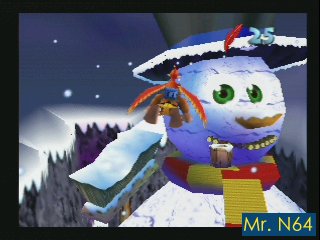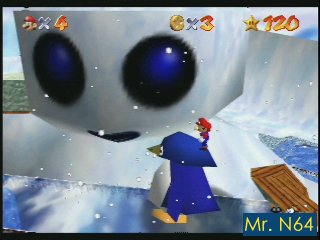|
|
||
|
Ever since Donkey Kong Country for the SNES, Rare has been known for taking existing game genres and making them look and sound like something new. Killer Instinct was a visually improved 2D fighting game. Diddy Kong Racing was a modified Mario Kart style racer, and Goldeneye was a reworked version of the Doom genre. In keeping with this tradition, Rare has produced Banjo-Kazooie, the first game to follow up on the genre created by Super Mario 64. Fortunately, despite it’s similarities with Nintendo’s breakthrough title, Banjo-Kazooie feels and plays very differently. The similarities to Mario 64 are relatively few. They include similar camera controls, and a similar structure, with the game having one central area containing doors to the main levels. The last notable similarity is the identical concept of collecting objects scattered throughout the game. The objects to be found in Banjo-Kazooie are similar to Mario 64's, but there are more different types. The five red coins in Mario's levels have been replaced with five colorful birds in Banjo-Kazooie. Mario’s stars have been replaced with puzzle pieces, and the coins have been replaced with music notes. In addition to these objects, there are red feathers to allow for flight, yellow feathers that allow for limited invincibility, and metal skulls to pay for the shaman Mumbo to change Banjo into different animals. Collecting these items is the bulk of the game. Collecting the items in Banjo-Kazooie is tougher than collecting the items in Mario 64. What makes Banjo-Kazooie more difficult is the not-so-hot play control and disproportionate speed of the enemy characters. Many of Banjo and Kazooie’s moves require button combinations, and even after the buttons have been pressed, the move won’t execute immediately. This makes it very common to be hit while attacking, and it can make the game frustrating at times. Attacking isn’t as easy or intuitive as in Mario either. Jumping on bad guys (the most basic videogame attack for more than 10 years now) rarely gets rid of an enemy. Additionally, in order to punch an enemy, you must be moving slowly and press B. If you’re moving too fast and press B, you’ll roll, which can move you away from where you want to be -- sometimes even off the edge of a platform. The control in general is slower and more sluggish than Mario 64’s. The underwater controls can be painfully slow to respond and frustratingly inaccurate. There are other problems as well. The camera is often in a bad place, regularly obscuring the view. The camera is also placed higher overhead than in Mario, limiting your view into the distance. Additionally, it is also very difficult to aim Kazooie’s egg projectiles using the control stick. The slightest nudge to the side while holding Z to aim an egg seems to turn Banjo and Kazooie a good 45 degrees. Another big flaw is the ease with which Banjo can fall of ledges. Even at the slowest creep, Banjo will walk right off a ledge, and he can’t grab it like Mario can. A unique aspect to the controls is the way that the game teaches them to you. Banjo-Kazooie is the first game I’ve played that doesn’t need an instruction manual. Bottles the Mole teaches you everything you need to know, when you need to know it. In fact, even if you already know what buttons to push, you can’t execute all the moves until Bottles has taught them to you. There are also special power-ups and items that require you to find Bottles before you can use them. Standing back and looking at the whole picture, Banjo-Kazooie can be a great deal of fun. There haven't been many games for the N64 recently that have kept me playing like Banjo-Kazooie did. The game isn’t so much about finding things (as was the case with Mario 64), as it’s about collecting things without losing a life. It feels a little more frantic than Mario 64. Something about it kept me playing and playing even though the control frustrated me occasionally. It was just plain fun to move between the cartoon areas and see what I would experience next. As usual, Rare has shown that it can take any genre and make it look and sound better. The graphics in Banjo Kazooie are amazing. The game has the largest N64 cartridge size yet, and it shows. The number of textures and polygons on screen makes Mario look like a paint-by-number picture in comparison. Skinned joints make the characters look more solid as well. Take a look at the screen caps below (the black borders are due to my video capture device):
As you can see, Banjo-Kazooie’s snowman is considerably more detailed than the snowman in Mario 64. Even more amazing is the fact that this giant creation is in the center of a large, equally detailed world. The sound in Banjo-Kazooie is wonderful as well. The game truly captures that classic cartoon sound, and features several tracks that change based on where you are. For example, as you enter the room with the entrance to the Egyptian level, you’ll hear an oboe enter the mix to capture the feel of the area. The sound effects are also excellent. They’re definitely cartoon quality. There is no voice in the game, but there are voice sounds that accompany on-screen text. Believe it or not, this works very well. Banjo-Kazooie is rated E for everyone, and clearly it’ll be good fun for most anyone, but there are a few things some parents might want to take note of. First of all, the dialogue features numerous cartoon insults from all the characters (bird brain, worm breath, geeky, etc.). Kazooie is especially quick to insult. There is also repeated use of the words butt and hag, but nothing worse than that. I only mention this because I could easily see a very young child picking up these phrases and repeating them endlessly. Overall, while the control was a problem, I liked Banjo-Kazooie quite a bit. In the seven plus hours that I logged during my evaluation, I got 40% through the game, and I wanted to keep playing. I still prefer the slower paced Mario 64, but Banjo-Kazooie was definitely worth the cost of my rental, and if I had some cash to burn I’d seriously consider purchasing it. Even so, I don't think it's quite as good as it needs to be for a Safe Buy rating. It's not bad at all, it's just not good enough to buy it without trying it. If you give Banjo-Kazooie a rental and the control doesn't bother you too much, you might just end up plunking down $50 for your very own copy. | ||
| Overall Rating: Rent Before Buying | ||
|
||
|
|
||
|
|

